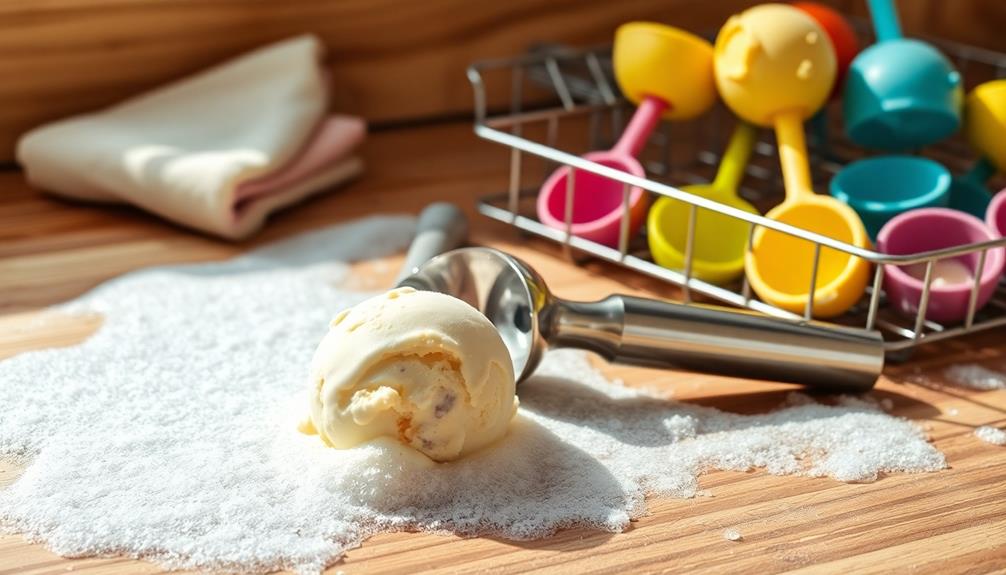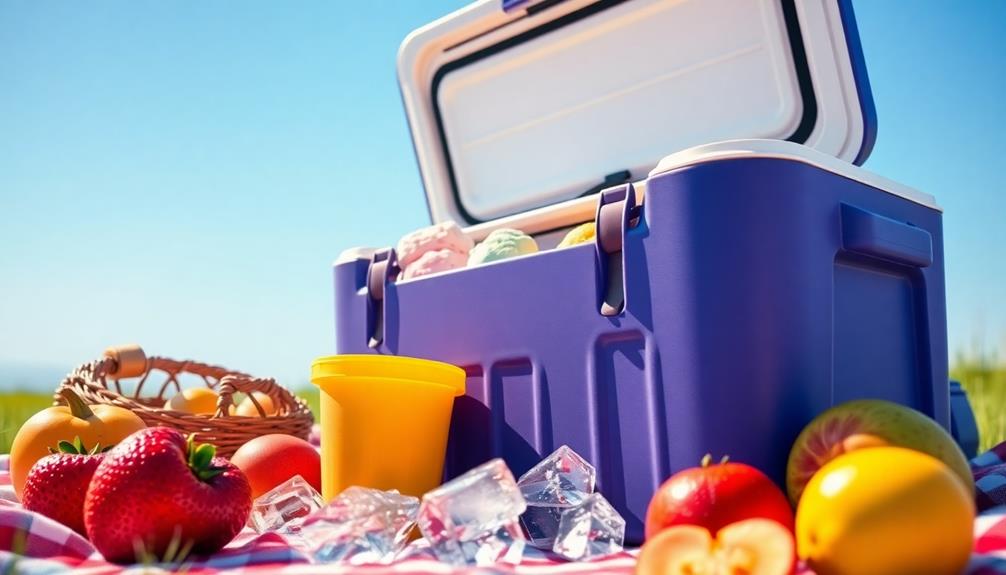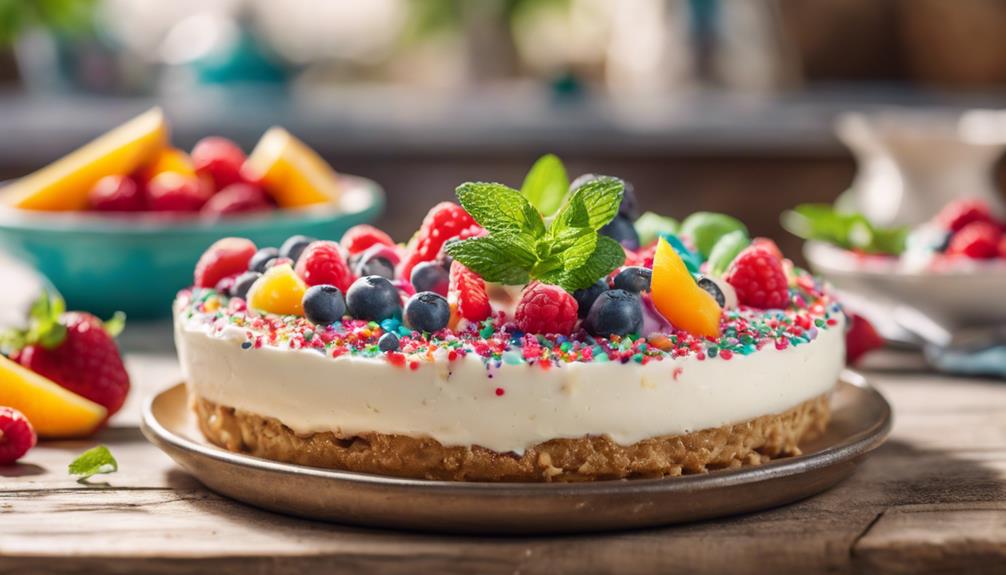To keep your ice cream scoop clean and in great shape, start by rinsing it under lukewarm water immediately after use. Use a non-abrasive sponge with warm, soapy water to scrub it, paying attention to hard-to-reach areas. After rinsing thoroughly, dry it completely to prevent moisture build-up. Regularly inspect your scoop for wear, and replace it if you notice significant damage. Remember, maintaining your scoop can enhance the quality of every scoop of ice cream. Want to guarantee you're doing everything right for peak performance? You'll discover even more helpful tips ahead.
Key Takeaways
- Regularly clean ice cream scoops using warm, soapy water to maintain hygiene and prevent bacteria buildup.
- Hand washing is preferred to avoid oxidation and preserve the scoop's integrity.
- Disassemble the scoop for thorough cleaning, soaking parts in warm, soapy water for at least 15 minutes.
- Inspect scoops for wear or damage regularly and replace them if significant tarnish or malfunctions are noticed.
- Establish a regular cleaning schedule, including daily washing and weekly inspections, to ensure optimal performance.
Importance of Regular Cleaning
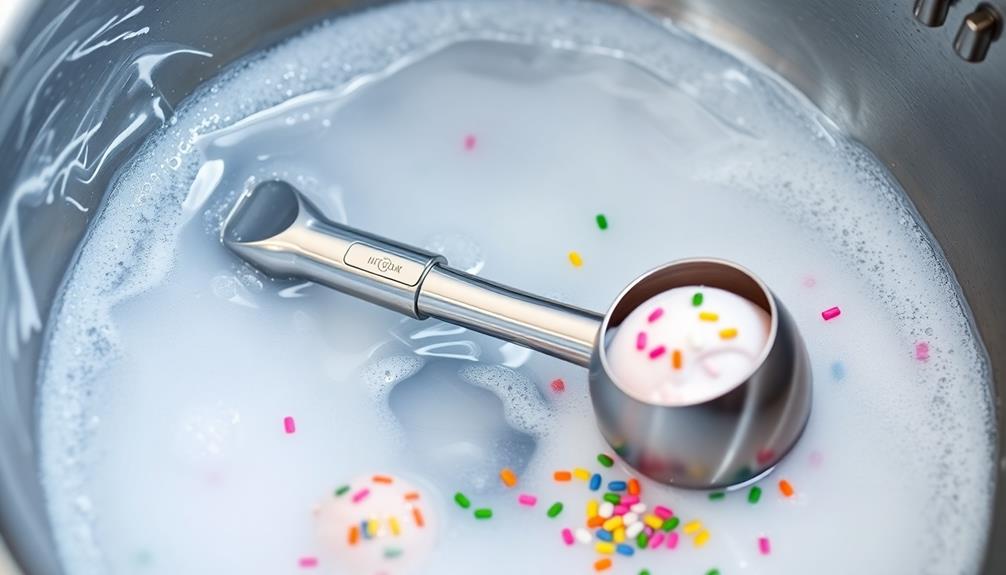
When you regularly clean your ice cream scoop, you not only guarantee hygiene but also enhance your ice cream experience. Regular cleaning is essential to prevent the buildup of bacteria and old mix residue. This maintains hygiene and safety, which is especially important when preparing food.
By hand washing your scoop instead of using a dishwasher, you preserve its integrity and avoid oxidation, which can cause tarnishing. Rinsing your scoop immediately after each use is another important step. This simple act prevents flavor crossover, so you'll enjoy the distinct taste of each ice cream flavor without mixing them.
Cleaning your scoop with warm water further enhances its performance; it helps prevent ice cream from sticking, making scooping easier and more efficient. Maintaining and regularly cleaning your scoop not only extends its lifespan but also improves the overall quality and presentation of the ice cream you serve.
A well-cared-for scoop makes a noticeable difference in the ice cream experience, guaranteeing every scoop is as delightful as the last. So, make regular cleaning a habit, and you'll elevate your ice cream enjoyment to a whole new level!
Essential Cleaning Supplies
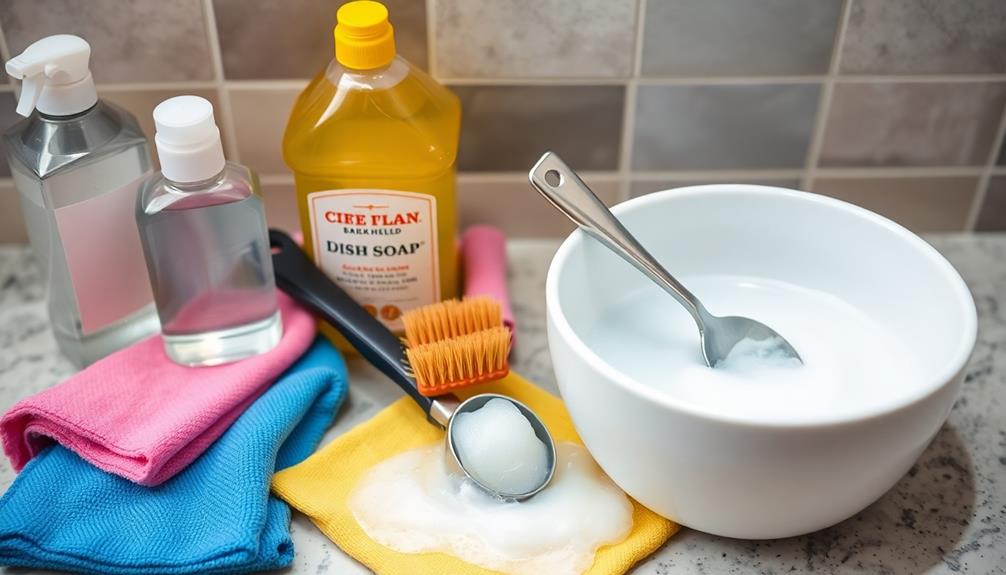
To keep your ice cream scoop in top condition, having the right cleaning supplies is vital. Start with a non-abrasive sponge or cloth, as this will help you clean without scratching the surface.
Don't forget a food-grade brush; it's perfect for getting into those hard-to-reach areas that a sponge might miss.
Next, you'll need a sanitizer solution, like Stera-Sheen, which is important for disinfecting your scoop after cleaning. This step eliminates harmful bacteria and guarantees your scoop remains food safe.
Additionally, using a food-safe lubricant on the scoop's moving parts will help maintain peak performance and prevent wear over time.
Storing your cleaning supplies properly is key; keep them in a cool, dry place to preserve their effectiveness.
Make sure all chemicals are sealed tightly to prevent leaks or spills. Regularly check your supplies and replace any worn or damaged items to uphold hygiene standards and prolong your scoop's lifespan.
Step-by-Step Cleaning Process
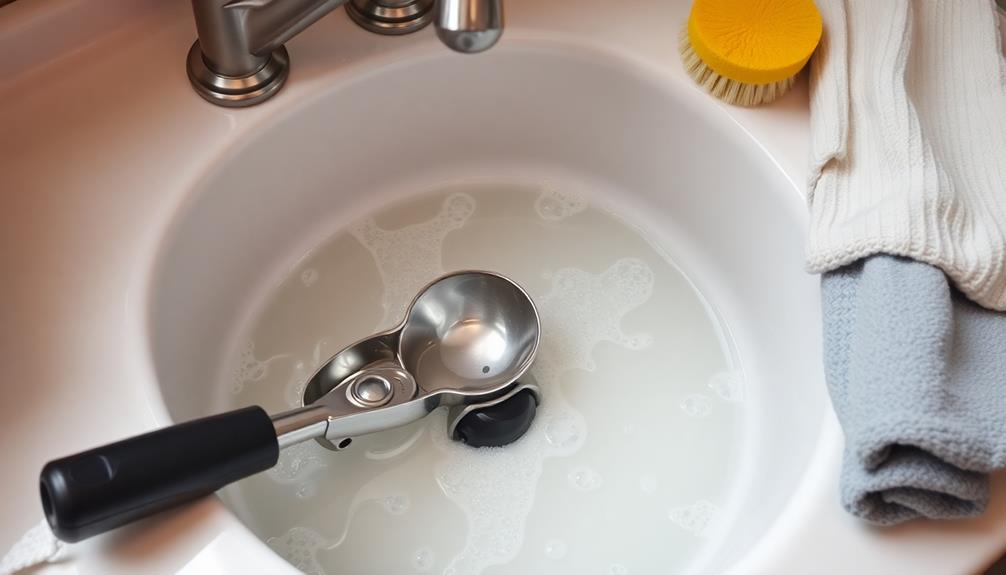
A thorough cleaning process guarantees your ice cream scoop stays in excellent condition. Follow these steps for ideal maintenance:
| Step | Action |
|---|---|
| 1. Drain Leftovers | Remove any leftover ice cream mix from the scoop. |
| 2. Rinse | Rinse the scoop under lukewarm clean water to eliminate residues. |
| 3. Disassemble | Carefully disassemble the scoop following the manufacturer's guidelines. |
| 4. Soak | Soak the parts in warm, soapy water for at least 15 minutes to loosen debris. |
| 5. Scrub and Rinse | Use a non-abrasive sponge to scrub the parts and rinse thoroughly with warm water. |
After rinsing, make certain to dry all components completely. This step is essential; moisture can lead to mold growth, which you want to avoid. By regularly maintaining your ice cream scoop with this cleaning process, you can guarantee it's always ready for your next delicious treat. Keep it clean, and your scoop will serve you well for years to come!
Common Issues and Solutions
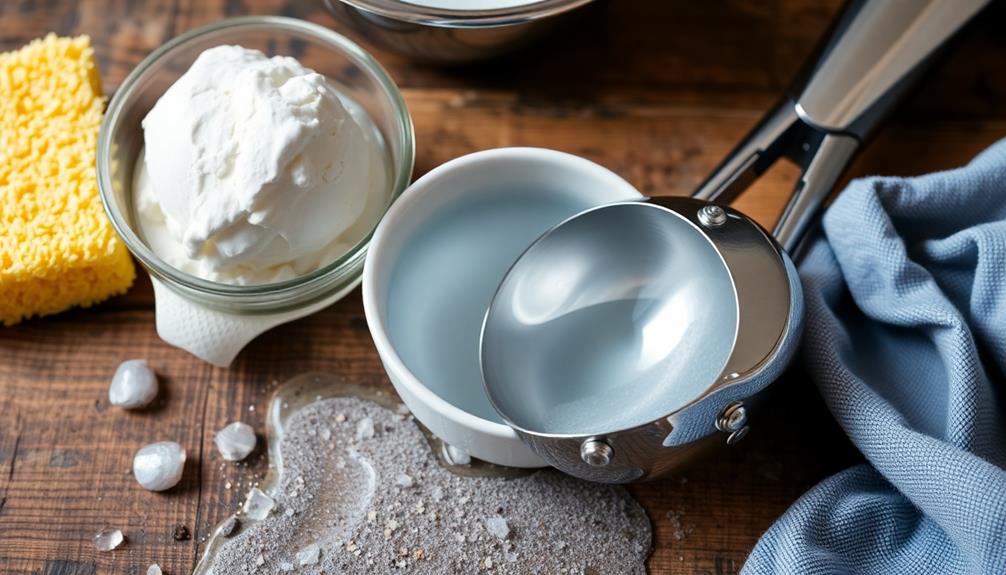
Ice cream scoops can encounter a variety of common issues that affect their performance and longevity. By addressing these problems early, you can keep your scoop in great shape and guarantee that you can enjoy your favorite frozen treats without hassle.
Here are some common issues and their solutions:
- Tarnishing: If you notice tarnishing, it's likely due to oxidation from the dishwasher. To prevent this, always hand wash your scoop and regularly clean it after use.
- Malfunctioning Scoop: If your scoop struggles to penetrate frozen tubs, it may have been exposed to extreme temperatures. Avoid using boiling water or excessive heat to protect its integrity.
- Wear and Damage: Regularly inspect your scoop for cracks or wear. This is vital for performance and helps prevent cross-contamination. If you find any damage, consider replacing it.
For best results, remember to rinse your scoop with warm water after each use and allow it to dry thoroughly.
Enhancing Ice Cream Quality
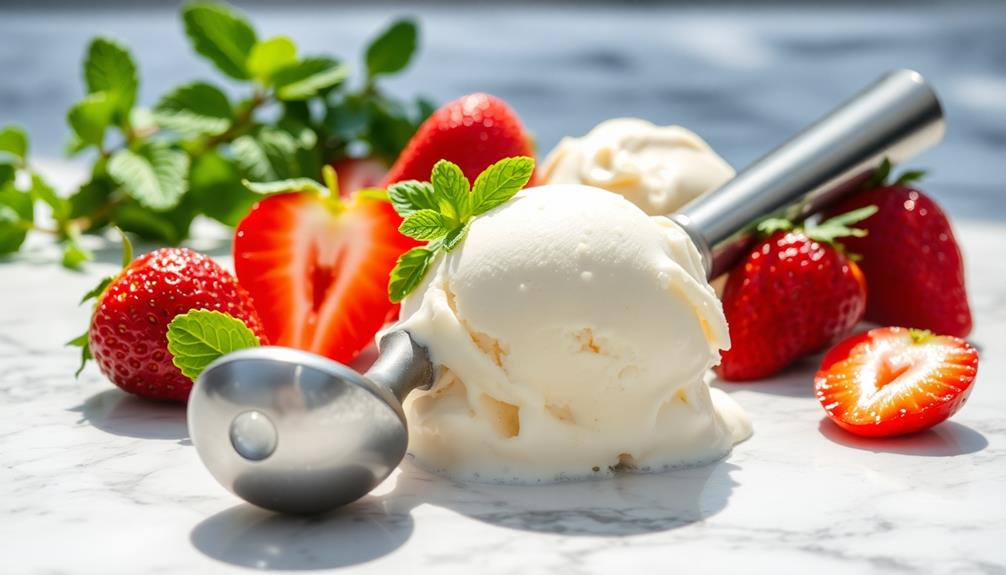
To enhance your ice cream quality, start by selecting the freshest ingredients you can find.
You'll also want to keep a close eye on your storage temperatures, ensuring they stay between -18°C to -12°C.
These steps help maintain the flavor and texture you're aiming for in every scoop.
Optimal Ingredient Selection
Crafting exceptional ice cream hinges on the quality of your ingredients. To elevate your ice cream mix, focus on using the best practices that enhance flavor and texture. Here are three key components to take into account:
- Fresh, High-Quality Ingredients: Always opt for fresh cream, milk, and sugar. These foundational components greatly impact the overall taste and texture of your ice cream.
- Natural Flavorings: Choose pure vanilla extract or fresh fruit purees over artificial additives. This switch can profoundly improve the authenticity and richness of your ice cream.
- Fat and Sugar Ratio: Monitor your fat and sugar levels closely. Aim for a fat content of around 14-20% for a creamier texture, while maintaining balanced sugar levels to prevent iciness during freezing.
Additionally, think about using natural stabilizers and emulsifiers like guar gum or lecithin to enhance mouthfeel and prevent ice crystal formation.
Regular taste tests with seasonal ingredients can further refine your flavor profiles, helping you craft a truly delightful ice cream experience.
Consistent Temperature Monitoring
Maintaining consistent temperatures is essential for producing high-quality ice cream. To achieve the perfect texture and flavor, you should store soft-serve ice cream between -18°C and -12°C. Regular temperature checks guarantee that these conditions are met, preventing any fluctuations that could compromise your ice cream's consistency and safety.
It's important to calibrate your equipment frequently. This practice helps eliminate temperature variations that could negatively affect the ice cream quality. Utilize thermometers to monitor both storage and serving temperatures; this step is critical for food safety and quality assurance in your operations.
Don't forget to document temperature checks. Keeping a reliable record not only aids compliance with health and safety standards but also guarantees that every batch of ice cream is safe for consumption.
Lastly, train your staff on the importance of temperature control. They need to understand how essential it's to preserve the integrity of your ice cream flavors and textures.
Dishwasher Risks for Scoops
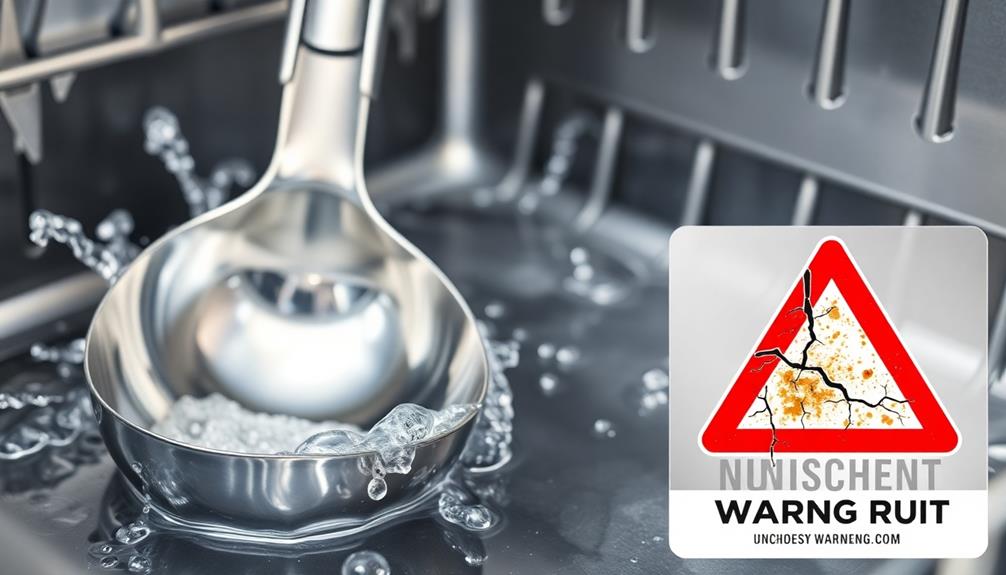
When you toss your aluminium ice cream scoop in the dishwasher, it risks oxidizing and tarnishing, which can affect its look and performance.
The heat can also cause the conductive fluid inside to solidify, impairing its functionality.
To keep your scoop in top shape, hand washing is the best option.
Oxidation and Tarnish Issues
Oxidation and tarnish can quickly diminish the beauty and functionality of your aluminium ice cream scoop, especially if you toss it in the dishwasher. The exposure to harsh dishwasher detergents can initiate a chemical reaction that leads to blackening and tarnishing of the scoop's surface. This oxidation process not only affects the aesthetic appeal but also compromises its functional quality.
Here are three key risks associated with dishwasher use for your scoop:
- Chemical Reactions: Detergents can react with aluminium, causing oxidation that's often permanent.
- Heat Damage: The excessive heat from dishwashers can solidify the conductive fluid inside hollow scoops, impairing heat transfer and performance.
- Long-Term Effects: Repeated dishwasher exposure may lead to irreversible tarnish and potential malfunction of your scoop.
If you notice oxidation, natural remedies like lemon juice, vinegar, or oxalic acid can help remove some of the tarnish, but they mightn't completely solve the issue.
To maintain your scoop's integrity and functionality, hand washing is the best option.
Hand Washing Recommendations
To keep your aluminium ice cream scoop in top shape, hand washing is the way to go. The dishwasher might seem convenient, but it poses risks that can damage your scoop over time. High heat and harsh detergents can lead to oxidation, causing blackening and tarnishing. Plus, the conductive fluid inside hollow scoops can solidify, impairing performance.
Instead, use warm water and a mild detergent to gently clean your scoop. After washing, be sure to dry it thoroughly to prevent moisture buildup. Avoid using boiling water, as extreme temperatures can harm the material and functionality.
Here's a quick reference for maintaining your ice cream scoop:
| Action | Recommended Approach | Notes |
|---|---|---|
| Washing | Hand wash with warm water | Prevents oxidation |
| Drying | Thoroughly dry | Avoid moisture buildup |
| Storage | Cool, dry place | Extends lifespan of the scoop |
Proper Water Contact Guidelines
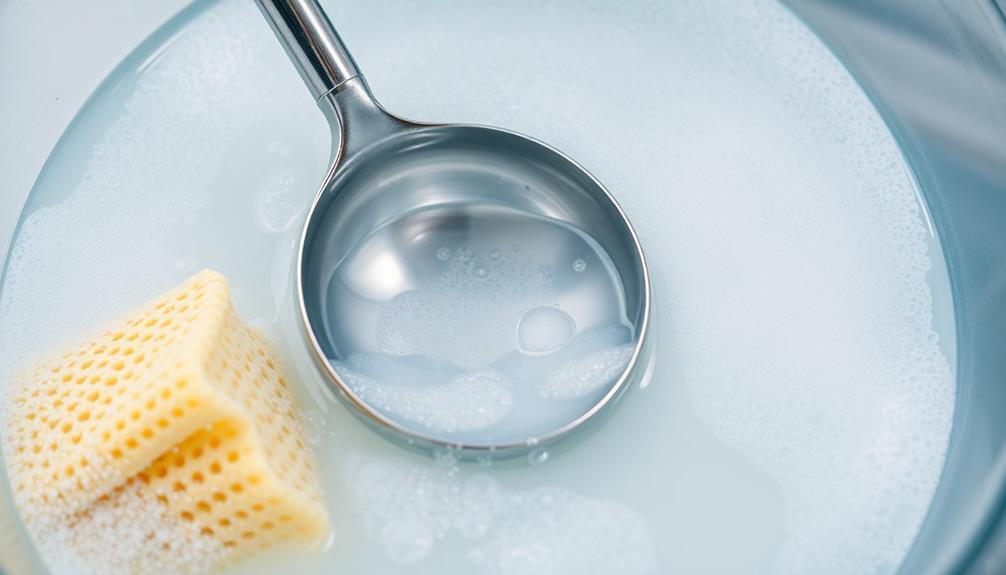
How can you guarantee your ice cream scoop stays in top shape? Proper water contact is key. Using warm water effectively not only helps melt the gelato but also makes scooping a breeze. Here are some guidelines to follow:
- Warm Water Rinse: Before you start scooping, rinse your scoop in warm water. This softens the ice cream, making it easier to scoop out perfect portions.
- Avoid Boiling Water: While warm water is beneficial, never use boiling water. Extreme temperatures can damage your scoop's integrity and reduce its lifespan.
- Regular Maintenance: Clean your scoop with warm water regularly. This practice keeps it functioning efficiently and prevents any unwanted flavor crossover between different ice cream flavors.
Maintenance Tips for Longevity

Maintaining your ice cream scoop is essential for ensuring it lasts and performs well over time. After each use, hand wash your scoop with warm soapy water. This simple step prevents oxidation and keeps the scoop's integrity intact, as dishwasher exposure can lead to unwanted tarnishing.
Store your scoop in a cool, dry place, away from extreme temperatures. This helps protect the conductive fluid within the hollow design. Regularly inspect your scoop for any signs of wear or damage. If you notice significant tarnish that can't be cleaned or any malfunctions, it's time to replace it.
Avoid prolonged exposure to extreme heat or cold; this can impair your scoop's performance and lead to premature wear.
To enhance the scoop's longevity, consider resting it in warm water before use. This not only facilitates easier scooping but also reduces stress on the material.
Equipment Hygiene Best Practices
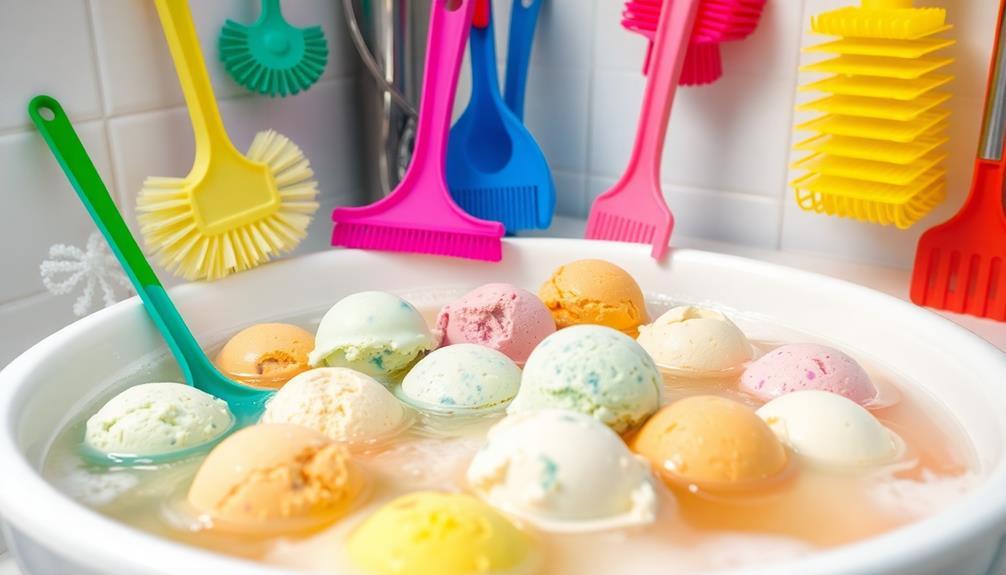
To keep your ice cream scoops safe and sanitary, you need a regular cleaning schedule.
Clean and disinfect your scoops with food-safe agents after each use, and set aside time for a thorough deep clean weekly.
This routine will help you prevent bacterial contamination and guarantee your equipment stays in top shape.
Regular Cleaning Schedule
Establishing a regular cleaning schedule for your ice cream scoops is essential to guarantee they stay hygienic and perform at their finest.
This routine not only guarantees the cleanliness of your tools but also prevents any flavor crossover between different ice cream varieties.
Here's how you can manage your cleaning effectively:
- Daily Cleaning: After each use, wash and dry your ice cream scoop by hand using warm soapy water. Avoid boiling temperatures, as they can damage the scoop's material.
- Weekly Inspection: Take a moment each week to inspect your scoop for any signs of wear or damage. If you notice any issues, replace the scoop immediately to maintain peak performance.
- Proper Storage: Store your scoop in a cool, dry place, away from extreme temperatures that could impair its functionality.
Additionally, document your cleaning and maintenance procedures to guarantee compliance with hygiene standards and track the longevity of your equipment.
Following this regular cleaning schedule will keep your ice cream machine running smoothly and your scoops ready for delicious creations.
Proper Cleaning Agents
When it comes to keeping your ice cream scoop in top condition, using the right cleaning agents is essential. Always opt for food-safe cleaning agents as per the manufacturer's instructions. This guarantees that your scoop remains hygienic and safe for use.
Regularly wash your scoop by hand with warm, soapy water to prevent oxidation and maintain its integrity.
Avoid abrasive cleaners or sponges, as they can scratch the scoop's surface and create hiding spots for bacteria. Instead, stick with soft cloths or sponges designed for delicate items.
After cleaning, rinse the scoop thoroughly to remove any residual cleaning agents, which could affect the flavor of your ice cream.
Store all your cleaning supplies, including sanitizers, in a cool, dry place to maintain their effectiveness and prevent spills. This simple practice helps guarantee that your cleaning routine remains efficient and safe.
Staff Training for Safety
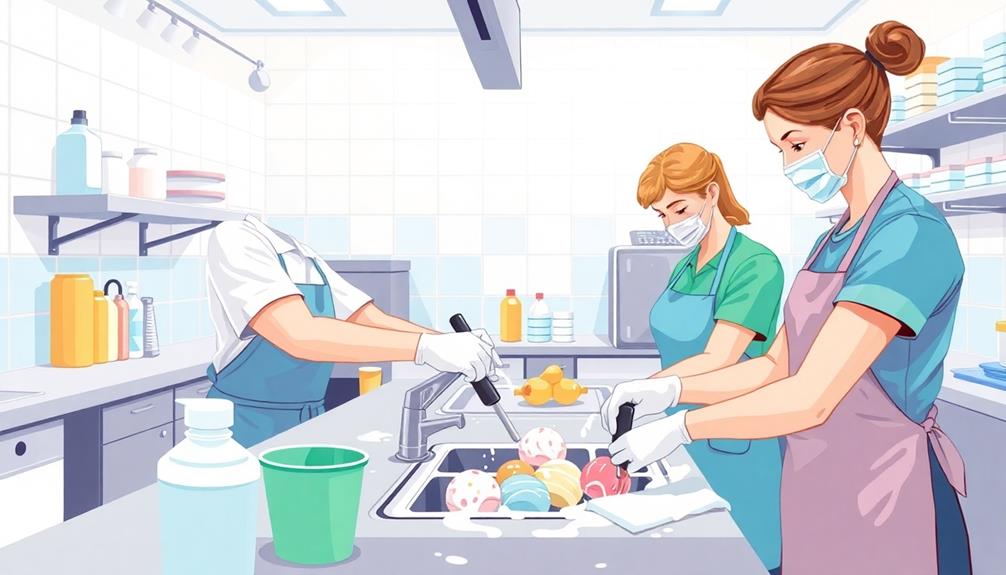
Training your staff on safety is essential for maintaining a clean and hygienic environment in your ice cream shop. By prioritizing food safety, you not only protect your customers but also foster a responsible workplace culture.
Here are three key areas to focus on during staff training:
- Handwashing and Glove Use: Make certain employees understand the importance of regular handwashing and proper glove usage when handling ice cream and toppings. This helps prevent cross-contamination.
- Allergen Awareness: Educate your team about common allergens found in ice cream and toppings. They should know how to handle customer inquiries regarding ingredient safety confidently.
- Routine Checks and Refresher Courses: Implement regular refresher courses on hygiene and safety protocols. Monitor staff performance through routine checks, providing constructive feedback to promote accountability in food safety.
Additionally, encourage your staff to utilize hand sanitizers at service points to enhance hygiene measures.
Frequently Asked Questions
How Do You Clean Ice Cream Scoops?
To clean ice cream scoops, wash them by hand with warm, soapy water and a non-abrasive sponge. Rinse well, soak in lemon juice or vinegar occasionally, and dry completely before storing to prevent moisture buildup.
How to Fix an Oxidized Ice Cream Scoop?
To fix an oxidized ice cream scoop, mix equal parts lemon juice and baking soda into a paste, apply it, and gently scrub. For tough tarnish, soak in vinegar-water solution before scrubbing with a food-safe brush.
How to Make Ice Cream Scoops Ahead of Time?
To make ice cream scoops ahead of time, pre-scoop into portions, freeze them on a parchment-lined sheet, and store in an airtight container. This way, you'll always have ready-to-serve ice cream on hand.
Why Do My Ice Cream Scoops Get Pitted?
Your ice cream scoops can get pitted like a weathered stone, primarily due to oxidation from harsh detergents and moisture trapped inside. Regular hand washing and inspecting for damage can help maintain their integrity and performance.
Conclusion
By keeping your ice cream scoop clean and well-maintained, you're not just prolonging its life; you're also ensuring every scoop is a delight. Think of it as giving your favorite dessert the royal treatment! Regular cleaning and proper maintenance will enhance the quality of your ice cream, making each serving a creamy masterpiece. So, don't overlook those simple steps—your customers (and their taste buds) will thank you for it!
